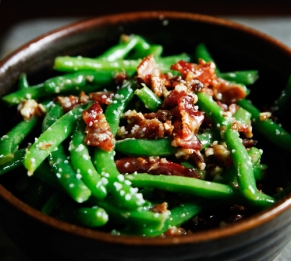Last week we outlined Twin Pines’ advice for growing delicious summer Zucchini. This week, we’ll walk you through the When, Where, and Care for Growing Green Beans in your summer garden!
Don’t forget: Check back weekly for gardening tips, guides, and even some favorite summer veggie recipes from the Twin Pines Team!
Green Beans –
Green Beans are a delicious summer vegetable, and a fun summer plant to garden! There are a variety of types of Green Beans, including Pole Beans, Bush Beans, Runner Beans, Yardlong Beans, and more! In this article, we will focus on the two most popular variations: Pole Beans and Bush Beans.
When To Plant:
Green Beans of any type should be planted after soil has warmed up during the late spring months. There should be full sun available to the plants for many hours of the day, making post-summer solstice timing ideal.
Where To Plant:
These delicious veggies should be planted in fertile soil that is rich in nutrients. If you can find a way to include compost into the garden beds you plant them in, they will also thrive.
Growing Pole Beans:
Green Beans that are grown on a vertical pole are a popular option, as they not only grow into delicious vegetables, but save a lot of space in a garden as they grow towards the sun.
Before you begin, you must first build a tipi or trellis for the plant to grow around. Once this structure has been built, for the best results be sure to plant pole beans about 6-10 inches apart so they have plenty of distance to grow.
Keep in mind that these plants will climb upwards over time on a vine that may reach up to 15 feet tall. For that reason we recommend creating a structure that extends as far and that can last through the season, as Pole Beans also tend to produce over and over again through the first frost of fall. This is one of the biggest benefits of choosing Pole Beans over Bush Beans, which do not produce as continuously.
Growing Bush Beans
Unlike Pole Beans, Bush Beans grow horizontally on their own bushes rather than up towards the sky. The shorter height of these plants, which typically does not exceed two feet, is often more conducive to a generic garden’s shape and size.
To grow these Bush Beans, plant seeds 3-6 inches apart with a 1-2 feet of space between the rows in soil that is drained but has a great exposure to sun. These plants should produce a crop in about two weeks, and will also continue to grow throughout the season. That being said, in order to grow the largest amount possible, replant a couple weeks apart for the best results.
Post-Planting Care
Although drained soil is ideal for planting purposes, it is incredibly important to keep soil moist during flowering and fruiting. For that reason, experts recommend using mulch along the base of plants to help lock in the moisture and keep the soil cool during hot months.
Gardeners should also be sure to water the beds evenly until the seedlings begin emerging from the ground, with about 1-1.5 inches of water per week. Green Beans will thrive best with a drip irrigation system as opposed to overhead or garden hose watering.
Harvesting The Green Beans
Unlike some other vegetable varieties, Green Beans should be harvested at an immature stage, before the seeds have fully developed.
To physically harvest the plant, locate a single pod that looks to be about mature in size and snap or cut it off from the vine without tearing the plant. If a bean is fresh and ready to be picked, it should snap off the vine without difficulty.
In order to keep the harvest going all summer long, its is recommended to sow beans every two or so weeks.
*Bonus: Twin Pines’ Favorite Green Bean Recipes*




